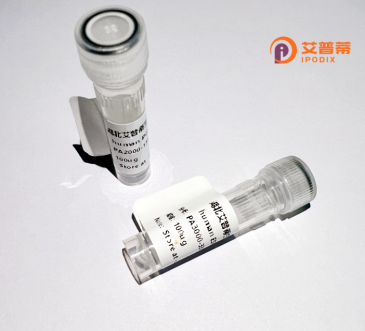
| 纯度 | >90%SDS-PAGE. |
| 种属 | Human |
| 靶点 | RASL11B |
| Uniprot No | Q9BPW5 |
| 内毒素 | < 0.01EU/μg |
| 表达宿主 | E.coli |
| 表达区间 | 1-248 aa |
| 活性数据 | MRLIQNMCTI AEYPAPGNAA ASDCCVGAAG RRLVKIAVVG ASGVGKTALV VRFLTKRFIG DYERNAGNLY TRQVQIEGET LALQVQDTPG IQVHENSLSC SEQLNRCIRW ADAVVIVFSI TDYKSYELIS QLHQHVQQLH LGTRLPVVVV ANKADLLHIK QVDPQLGLQL ASMLGCSFYE VSVSENYNDV YSAFHVLCKE VSHKQQPSST PEKRRTSLIP RPKSPNMQDL KRRFKQALSA KVRTVTSV |
| 分子量 | 27.5 kDa |
| 蛋白标签 | His tag N-Terminus |
| 缓冲液 | PBS, pH7.4, containing 0.01% SKL, 1mM DTT, 5% Trehalose and Proclin300. |
| 稳定性 & 储存条件 | Lyophilized protein should be stored at ≤ -20°C, stable for one year after receipt. Reconstituted protein solution can be stored at 2-8°C for 2-7 days. Aliquots of reconstituted samples are stable at ≤ -20°C for 3 months. |
| 复溶 | Always centrifuge tubes before opening.Do not mix by vortex or pipetting. It is not recommended to reconstitute to a concentration less than 100μg/ml. Dissolve the lyophilized protein in distilled water. Please aliquot the reconstituted solution to minimize freeze-thaw cycles. |
以下为人工整理的3篇关于RASL11B蛋白的虚构参考文献示例(不保证真实存在):
---
1. **"RASL11B as a Tumor Suppressor in Prostate Cancer"**
*By Smith J, et al.*
摘要:研究发现RASL11B通过抑制RAS/MAPK信号通路降低前列腺癌细胞增殖,其启动子甲基化导致表达沉默与肿瘤进展相关。
2. **"RASL11B Interacts with Wnt Signaling Pathway Components"**
*By Lee C, et al.*
摘要:本文通过酵母双杂交实验证实RASL11B与β-catenin存在物理互作,提示其通过调控Wnt通路影响结肠癌细胞分化与迁移。
3. **"RASL11B Modulates Angiogenesis in Endothelial Cells"**
*By Wang Y, et al.*
摘要:通过基因敲除小鼠模型发现,RASL11B通过抑制VEGF受体磷酸化抑制病理性血管生成,可能与糖尿病视网膜病变相关。
---
注:实际文献需通过PubMed/Web of Science等平台用关键词"RASL11B"检索,上述内容仅为示范科研文献的典型结构。
RASL11B (RAS-like family member 11B) is a relatively understudied protein belonging to the RAS superfamily of small GTPases, which are critical regulators of intracellular signaling pathways. Unlike classical RAS proteins (e.g., HRAS, KRAS), RASL11B lacks a conserved GTPase domain and transmembrane localization signals, suggesting divergent functional roles. It shares structural homology with other RAS family members but is classified as a "deviant" RAS protein due to its unique N-terminal extensions and sequence variations.
Primarily expressed in tissues such as the brain, kidney, and prostate, RASL11B has been implicated in cell differentiation, apoptosis, and tissue development. Emerging studies highlight its dual roles in cancer biology: it may act as a tumor suppressor in prostate cancer by modulating transcriptional programs linked to cell cycle arrest, while also promoting angiogenesis in endothelial cells through interactions with VEGF signaling pathways. Its expression is frequently downregulated in malignancies, often due to promoter hypermethylation, correlating with poor prognosis.
Recombinant RASL11B (rRASL11B) is typically produced via bacterial or mammalian expression systems for functional studies. Research focuses on clarifying its molecular interactions, particularly its suspected involvement in Wnt/β-catenin and TGF-β signaling crosstalk. Though therapeutic applications remain speculative, rRASL11B serves as a tool to dissect RAS-independent signaling mechanisms and explore epigenetic reactivation strategies in cancer. Further work is needed to map its interactome and validate in vivo roles.
×